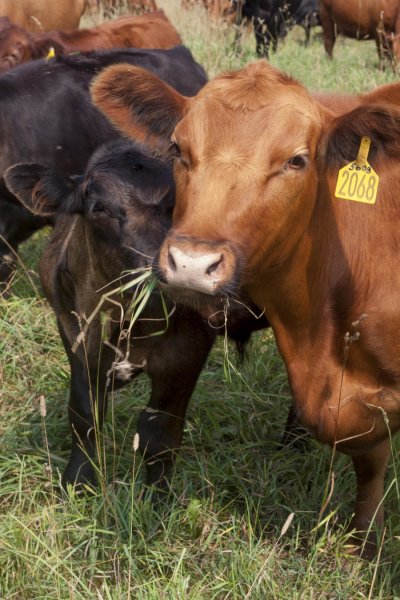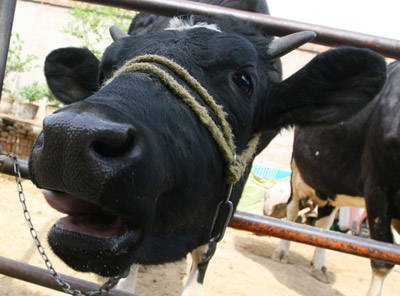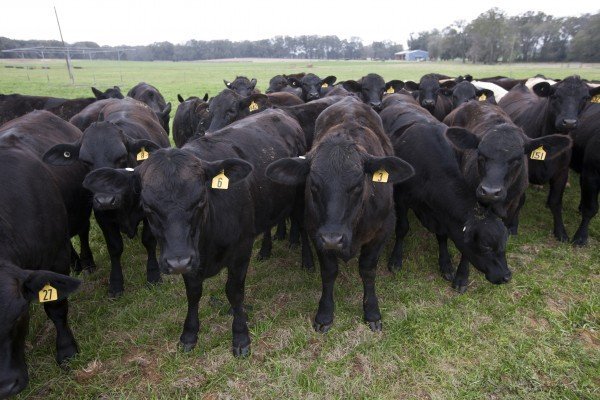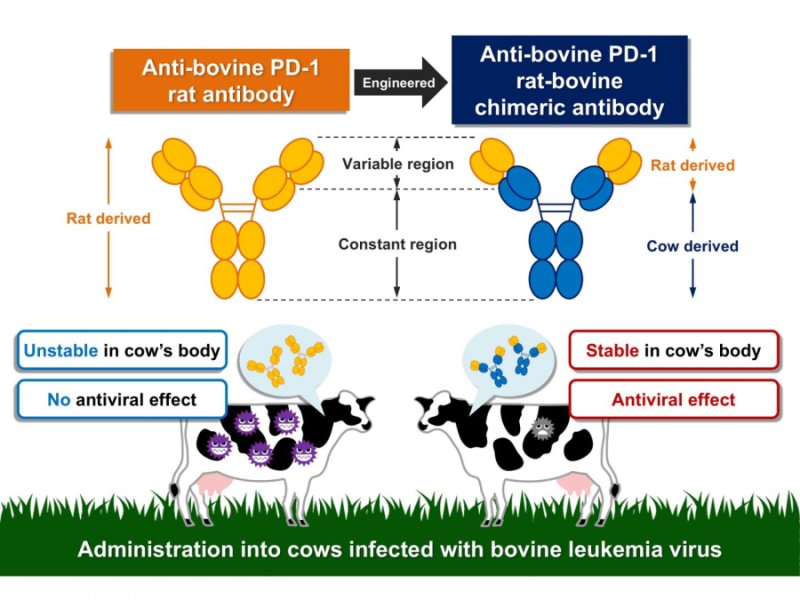-

Newly discovered infectious prion structure shines light on mad cow disease
Groundbreaking research from the University of Alberta has identified the structure of the infectious prion protein, the cause of “mad cow disease” or BSE, chronic wasting disease in deer and elk and Creutzfeldt-Jakob disease in humans, which has long remained a mystery. The infectiou...Read more -

New study finds clear differences between organic and non-organic milk and meat
In the largest study of its kind, an international team of experts led by Newcastle University, UK, has shown that both organic milk and meat contain around 50% more beneficial omega-3 fatty acids than conventionally produced products. Analyzing data from around the world, the team reviewed 196 p...Read more -

Researchers, farmers collaborate to prevent E. coli
A collaborative Michigan State University study involving microbiologists, epidemiologists, animal scientists, veterinarians, graduate students, undergraduates and farmers could lead to better prevention practices to limit dangerous E. colibacteria transmissions. The study, published in Applied ...Read more -

Vitamin D could help control TB in animals, new study shows
Research published in Research in Veterinary Science reveals that vitamin D supplementation reduces the incidence and severity of tuberculosis (TB) in wild boar and red deer. The pilot study of 40 animals was conducted by a multidisciplinary team of scientists from the University of Surrey (UK), ...Read more -

Odors can be measured by analytical chemistry
Usually, it takes a nose to smell, but now — for the first time — scientists have developed a convincing model able to measure odours from pig farms by means of precise measurements of the content of odorants in the atmosphere. How much and how bad does pig production facilities smell...Read more -

New model could help improve prediction of outbreaks of Ebola and Lassa fever
Potential outbreaks of diseases such as Ebola and Lassa fever may be more accurately predicted thanks to a new mathematical model developed by researchers at the University of Cambridge. This could in turn help inform public health messages to prevent outbreaks spreading more widely. Many of the ...Read more -

Estrogen, antibiotics persisted in dairy farm waste after advanced treatment, research finds
When University at Buffalo chemists began studying waste disposal at a dairy farm in New York State, they thought that the farm’s advanced system for processing manure would help remove estrogens and antibiotics from the excrement. Instead, the scientists found that the chemicals largely pe...Read more -

New blood test for the detection of Bovine TB
A new blood test to detect Mycobacteria in blood has been developed by a team at The University of Nottingham led by Dr Cath Rees, an expert in microbiology in the School of Biosciences and Dr Ben Swift from the School of Veterinary Medicine and Science. The researchers have used this new method ...Read more -

Developing ways to study influenza D virus
Although a new influenza virus, now called influenza D, was discovered first in pigs, researchers found it was more common in cattle. However, further research has identified antibodies to the virus in small ruminants, but not in poultry. To identify exposure to the virus, South Dakota State Univ...Read more -

Horses communicate with eyes and mobile ears
Horses are sensitive to the facial expressions and attention of other horses, including the direction of the eyes and ears. The findings, reported in the Cell Press journal Current Biology on August 4, are a reminder for us humans to look beyond our own limitations and recognize that other specie...Read more -
Protein in, ammonia out
Ammonia gas packs quite the smelly punch. In small doses, it’s what makes smelling salts so effective. But high levels of ammonia can be a health hazard and a pollutant. Dairy farms are one of the major sources of ammonia emissions. The U.S. Environmental Protection Agency estimated that da...Read more -
Congratulations! Jianhua Tang, GM of Fangtong was selected as the “Three Hundred” Science and Technology Leading Talents in Chongqing
In accordance with the spirit of ”Notice for Application of Chongqing’s “Three Hundred” Science and Technology Leading Talents Support Program in 2018″. and followed the procedures of individual application, publicity and recommendation, qualification review, expert review, and direc...Read more -

Environmentally friendly cattle production
Three hundred years ago, enormous herds of bison, antelope and elk roamed North America, and the land was pristine and the water clean. However, today when cattle congregate, they’re often cast as the poster animals for overgrazing, water pollution and an unsustainable industry. While some ...Read more -

The threat of foot-and-mouth disease in New Zealand
The threat of foot-and-mouth disease in New Zealand Isolation and the early practice of quarantine and disease control have kept New Zealand livestock free of the more serious diseases found in animals in Europe, Asia and the Americas. This is an advantage for New Zealand, and keeps its livestock...Read more -

Scientists work to develop heat-resistant ‘cow of the future’
Scientists work to develop heat-resistant ‘cow of the future’ University of Florida scientists are working to breed the “cow of the future” by studying the more heat-tolerant Brangus cow — a cross between an Angus and a Brahman. University of Florida scientists are ...Read more -
Researchers discover new cattle disease and prevent it from spreading
Researchers discover new cattle disease and prevent it from spreading Following genetic studies of deformed calves, research is able to uncover a previously unknown disease found among Holstein cattle. The breeding bull from which the mutation and thus the deformation originate has now been put d...Read more -
Protecting pigs from PRRS during reproduction
Protecting pigs from PRRS during reproduction In the words of Kansas State University researcher Raymond “Bob” Rowland, his latest work is helping to eradicate a devastating swine disease. The disease is caused by the porcine reproductive and respiratory syndrome, or PRRS, virus. The ...Read more -

Overcoming immune suppression to fight against bovine leukemia
Overcoming immune suppression to fight against bovine leukemia The anti-bovine PD-1 rat antibody (left) was found unstable in the cow’s body and had no antiviral effect. So, the research team formed a rat-bovine chimeric antibody (right) which successfully showed an antiviral effect. Bovin...Read more -

Fangtong is listed on Ministry of Agriculture’s honor roll
Fangtong is listed on Ministry of Agriculture’s honor roll Chongqing Fangtong Animal Pharmaceutical Co., Ltd, totally been sampled 294 batches, due to excellent product quality, sampling inspection results are fully complied with national standards. Chongqing Fangtong Animal Pharmaceutical Co....Read more -
The Reasonable Use of Antiparasite Drugs for Animals
The Reasonable Use of Antiparasite Drugs for Animals [Abstract] As the rapid development of scientific technology, especially the pharmaceutical industry, the kinds of antiparasite drugs increase rapidly. It’s of great importance to use antiparasite drugs reasonably. Currently, antiparasite drug...Read more -
Control Program of Hydatid
Control Program of Cystic Hydatid Disease (2013–2018) Cystic hydatid disease (hereinafter referred as CHD) in man is caused principally by infection with the larval stage of the dog tapeworm Echinococcus granulosus. It is an important pathogenic zoonotic parasitic infection (acquired from anima...Read more -

Antibiotics could be cut by up to one-third
Nine in 10 dairy farmers participating in a new survey from the Royal Association of British Dairy Farmers (RADBF) say that the farming industry must take a proactive lead in the battle against antibiotic resistance. Those questioned also think that over the next five years they could cut their o...Read more

